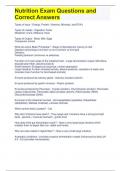Nutrition Exam Questions and
Correct Answers
Types of Input - Energy, Protein, Vitamins, Minerals, and EFA's
Types of Losses - Digestive: Fecal
Metabolic: Urine, Methane, Heat
Types of Output - Meat, Milk, Eggs
Companion animal
What are some Basic Principles? - Stage of development (young vs old)
Digestive physiology (ruminant vs non-ruminant vs hind gut)
Dentition
Feeding behavior (omnivore vs selective)
Function of 3 main areas of the intestinal tract - Large fermentation vessel: Microflora,
degrade plant fiber, absorb products
Small Intestine: Endogenous enzymes, nutrient absorption
Large Intestine: Further microbial activity, absorb products, resorption of water and
minerals (main function for land based animals)
Enzyme produced by salivary gland - Salivary amylase (starch)
Enzyme produced by gastric mucosa - Pepsin (protein)
Enzymes produced by Pancreas - Trypsin (protein), Chymotrypsin (protein), Pancreatic
Lipase (triglyceride), Pancreatic alpha-amylase (starch), Ribonuclease (RNA),
Deoxyribonuclease (DNA)
Enzymes of the intestinal mucosa - Aminopeptidase (peptides), Dipeptidase
(dipeptides), Maltase (maltose), Lactase (lactose)
Which animal lacks Lactase? - Cat
Why don't chickens have teeth? - They weigh alot, therefore have a strong but light
beak - gizzard = muscular stomach - grinds food
How does Hind gut fermentation work? - Have a very large large intestine which
enables them to digest fiber (ex: rabbit and horse)
Why are cats unable to digest fiber? - Have a very small large intestine
Anareobic conditions - provides massive fermentation vessel (influenced by diet); pH
5.5 - 6.5 (provides homeostasis)
, Nutrition Exam Questions and
Correct Answers
Products of rumen microflora - VFA's (main product), microbial protein, and gasses
(40% CO2, 30-40% CH4)
What are some negative effects to only feeding cows on pasture grass? - Low mineral
intake (ex: calcium); poor growth; Build up of pasture worms
What type of fermentation is ideal when producing silage? Why? - Anaerobic:
encourages rapid fermentation; reduction of moisture also important
What are 3 types of silage? - Grass, Maize, and Whole -crop wheat
What are some potential problems when making silage? - Variable weather conditions,
uncontrolled fermentations, potential hazards (pathogens, toxic chemicals, excess
acidity); too much H2O fermentation not fast enough
List some potential pathogens - E.Coli, Listeria monocytogenes, Clostridium botulinum,
Cryptosporidium parvum, Aspergillus fumigatus, Actinomycetes, Penicillium roqueforti
Mycotoxins = Fungal toxins
Potential diseases linked to micro-organisms - Diarrhea (E Coli, Crypto, etc); Mastitis (E
Coli, etc); Listeriosis (L monocytogenes); "Silage eye" (L monocytogenes?); Botulism (C
botulinum); Resp distress from fungal spores
Listeria monocytogenes - Crop contaminated w/ soil (happens when crop cut too close
to ground); wet silage; O2 infiltration into silage; mouldy silage fed to animals
Clostridium botulinum - Silage contaminated w/ carcass; wet silage; causes death
What are some clinical signs of Acidosis? - Excessive intake of minerals, preference for
straw, urine drinking, regurgitation, low milk fat %, diarrhea, hyperventilation, lethargy,
bloat
What is the treatment for acidosis? - NaHCO3, and long fiber to stimulate chewing and
rumination
What is different about Birds? - Do not have teeth, some have a crop ("short term"
storage and mucous secreting), Glandular stomach, Muscular stomach (grinds and
mixes)
Dentition: Carnivores - Large incisors and canines (rip food)
Dentition: Herbivores - Large molars and premolars (grind food)




